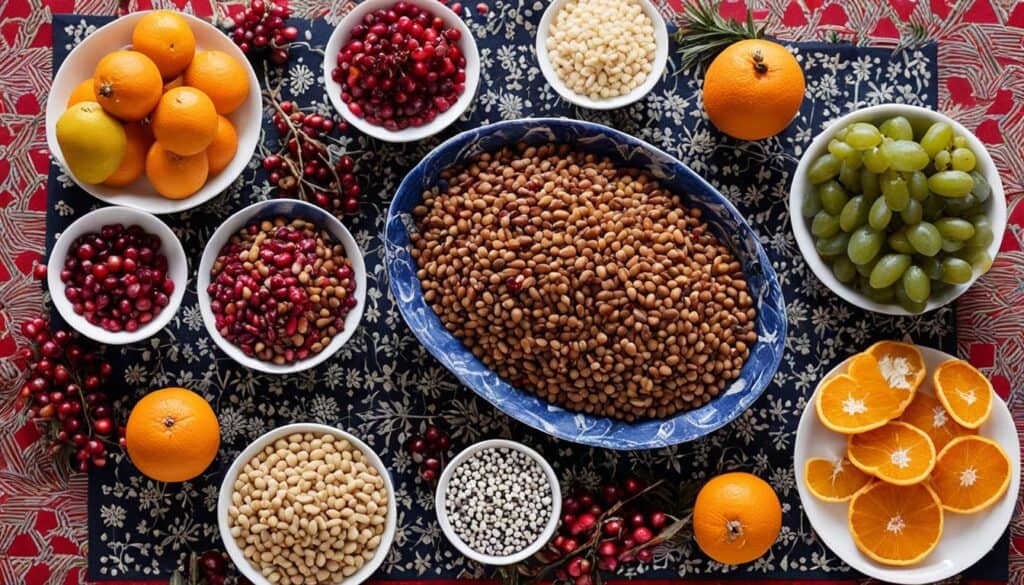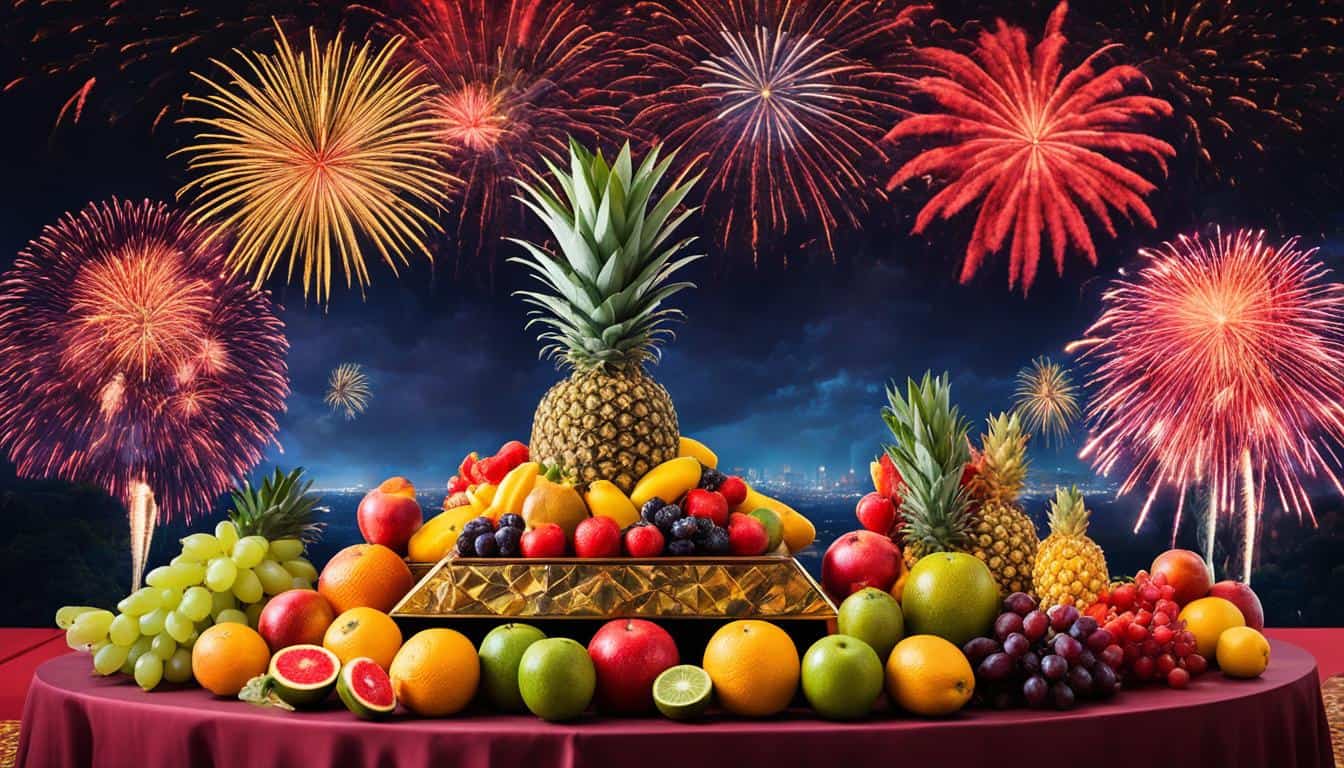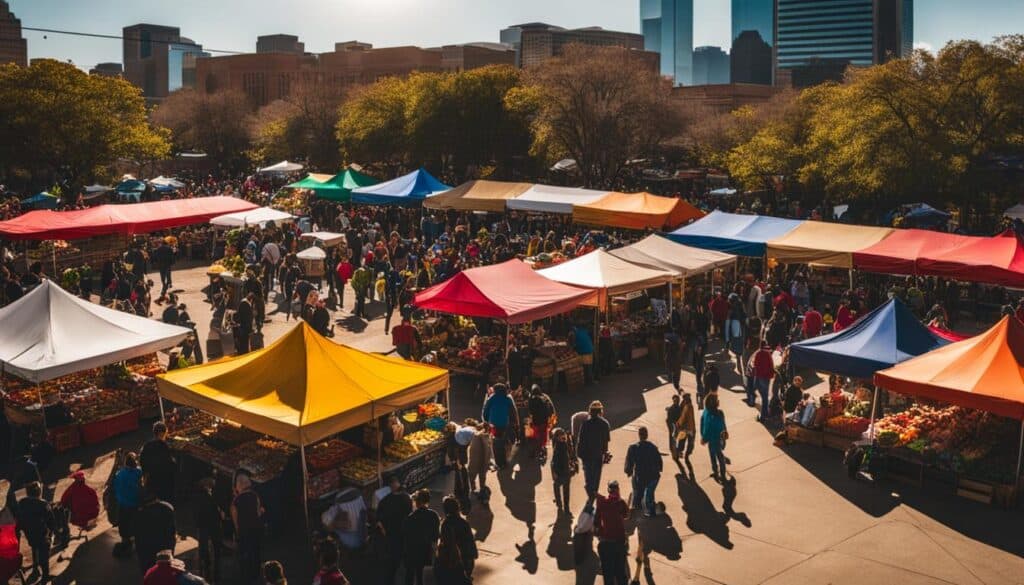As New Year approaches, many cultures around East Asia have unique traditions and customs to ensure a prosperous and luck-filled year. One such tradition is the offering and consumption of specific fruits during New Year’s celebrations. These fruits hold deep symbolic meanings and are believed to bring good fortune, abundance, and positive energy into the coming year.
In this article, we will explore the significance of fruits in various cultures’ New Year traditions and discover the popular fruits that are considered lucky for the New Year. From traditional fruit offerings to auspicious number rituals, we will learn the importance of fruit symbolism in New Year celebrations. So, let’s dive in and uncover the colorful world of New Year fruits!
Key Takeaways:
- New Year traditions in different cultures emphasize the importance of fruit offerings.
- Specific fruits are believed to bring good luck, wealth, and positive energy.
- Fruit symbolism plays a significant role in New Year celebrations around the world.
- Auspicious numbers, rituals, and traditions are associated with fruit offerings.
- Celebrating New Year with fruits is a way to start the year with positivity and hope.
Filipino Tradition: 12 Round Fruits for New Year’s Eve
In the Philippines, it is a tradition to have 12 round fruits on display for New Year’s Eve. These fruits are carefully chosen for their symbolism and significance in bringing good fortune and prosperity in the coming year. The round shape of the fruits represents coins and is believed to attract wealth and abundance.
The selection of fruits may include:
- Apples
- Oranges
- Pineapple
- Watermelon
- Grapes
- Melon
- Longan
- Coconut
- Pear
- Pomelo
- And more
Each fruit’s color and shape hold symbolic meanings:
| Fruit | Symbolic Meaning |
|---|---|
| Green and Purple Fruits | Prosperity |
| Pink Fruits | Good health |
| Red Fruits | Happiness and luck |
| Yellow Fruits | Happiness and unity |
| Orange Fruits | Gold and money |
This tradition is deeply rooted in Filipino culture, and the fruit offerings play a significant role in New Year celebrations. They are not only visually striking but also hold special meaning for families as they gather to welcome the new year with hope and positivity.
Superstitions and Beliefs in Filipino New Year’s Eve
In addition to the tradition of 12 round fruits, Filipinos have various superstitions and beliefs for good luck in the New Year. These customs and practices are deeply rooted in Filipino culture and are passed down through generations as a way to attract positive energy and ensure a prosperous year ahead.
Jumping High for Height and Fortune
One popular superstition involves jumping as high as possible as the clock strikes midnight. This act is believed to bring individuals growth, both in terms of physical height and financial fortune.
Driving Away Bad Luck with Noise
To ward off bad luck and drive away negative spirits, it is customary to make loud noises during New Year’s Eve celebrations. This can include setting off firecrackers, playing music, and creating a festive atmosphere. The goal is to invite positive energy and dispel any lingering negativity from the past year.
Welcoming Abundance with Open Lights and Rice Dispenser
In preparation for the New Year, Filipinos often keep all their lights open and ensure that the rice dispenser remains well-stocked. This symbolizes a warm welcome to prosperity, abundance, and good fortune in the coming year.
Symbolizing Circles and Money with Polka Dot Clothes
Wearing polka dot clothes on New Year’s Eve is a common belief among Filipinos. The circular shapes of the dots are thought to symbolize coins and bring about financial prosperity and abundance in the year ahead.
Attracting Money with Coin Throwing
Another traditional belief is to throw coins around the house during New Year’s Eve. This practice is believed to attract wealth and financial blessings into the home.
Symbol of Harmony and Unity: Sticky Rice
Eating sticky rice, known as “malagkit,” is a symbol of harmony and unity in the family. It is believed to bring a close bond between family members and ensure a harmonious relationship throughout the year.
Long Life and Noodles
Eating noodles during New Year’s celebrations is believed to bring long life. The length of the noodles symbolizes a long and prosperous future.
Family Togetherness for Unity and Harmony
One of the most important traditions during Filipino New Year’s Eve is the gathering of the entire family for a festive meal. Eating together promotes unity, harmony, and the strengthening of family bonds.
The Filipino culture embraces superstitions and beliefs as a way to invite good luck, abundance, and harmony into their lives. These traditions are an integral part of the New Year’s Eve customs and are celebrated with great enthusiasm.
Good Luck Foods Around the World
Different cultures around the world have their own traditions of celebrating the New Year with good luck foods. These foods are believed to bring fortune, prosperity, and positive energy for the coming year. Let’s explore some of the fascinating culinary customs from various countries:
China: Fish for a Year of Abundance
In China, serving fish with the head and tail intact is a popular New Year’s tradition. This dish symbolizes a good year from beginning to end and is believed to bring abundance and prosperity. The Chinese word for fish, “yu,” sounds similar to the word for surplus, emphasizing the idea of having more than enough.
Italy and Hungary: Lentils for Growing Prosperity
In Italy and Hungary, lentils take center stage during New Year’s celebrations. These tiny legumes, with their coin-like shape, are associated with wealth and growing prosperity. Eating lentils is believed to attract financial success and good fortune for the year ahead.
Germany, Poland, and Scandinavia: Pickled Herring for Abundance
In Germany, Poland, and Scandinavian countries, pickled herring is an essential part of New Year’s feasts. This fish, with its silver sheen resembling coins, is considered a symbol of abundance and good fortune. It is believed that consuming pickled herring will bring prosperity and a bountiful year ahead.
Japan and China: Long Noodles for Longevity
Longevity is the focus of New Year traditions in Japan and China. People in these countries believe that by eating long noodles, they will have a long and prosperous life. It is customary to slurp the noodles without breaking or chewing them, symbolizing the desire for uninterrupted happiness and good health.
Turkey: Pomegranates for Prosperity
In Turkey, pomegranates hold a special place in New Year celebrations. The vibrant red color and round seeds of this fruit symbolize prosperity and good luck. Breaking a pomegranate on the floor, revealing its juicy seeds, is believed to bring abundance and positive energy for the year ahead.
Cuba, Spain, Portugal, Austria, and Hungary: Pork for Progress
In many countries, including Cuba, Spain, Portugal, Austria, and Hungary, pork is considered a lucky food for the New Year. Pigs symbolize progress and forward movement, as they always root forward when they search for food. Eating pork during New Year’s celebrations is believed to bring progress, success, and prosperity for the coming year.

| Country | Lucky Food | Symbolism |
|---|---|---|
| China | Fish | Abundance and prosperity |
| Italy and Hungary | Lentils | Growing prosperity |
| Germany, Poland, and Scandinavia | Pickled Herring | Abundance and good fortune |
| Japan and China | Long Noodles | Longevity and happiness |
| Turkey | Pomegranates | Prosperity and positive energy |
| Cuba, Spain, Portugal, Austria, and Hungary | Pork | Progress and prosperity |
These are just a few examples of the fascinating ways different cultures celebrate the New Year with lucky foods. The food choices not only reflect cultural traditions but also carry profound symbolism and meaning. By incorporating these foods into their celebrations, people hope to invite good luck, prosperity, and happiness for the year ahead.
Lucky Foods in Southern States of the US
In the Southern states of the US, New Year’s is celebrated with a variety of lucky foods that are believed to bring prosperity and good fortune for the coming year. These regional New Year traditions are deeply rooted in the food symbolism of Southern US culture.
One popular tradition is the inclusion of green leafy vegetables like kale and collards in New Year’s meals. These vegetables are favored for their resemblance to paper currency, symbolizing wealth and financial success in the upcoming year.

Another favored food is black-eyed peas. These small legumes are believed to bring abundance due to their appearance similar to pennies. Including them in New Year’s meals is seen as a way to attract wealth and good luck.
Cornbread is another staple in Southern New Year’s celebrations. With its golden color and delicious taste, cornbread symbolizes wealth and prosperity. Some even go the extra mile by adding additional corn kernels to symbolize nuggets of gold, further enhancing the symbolism of wealth.
| Food | Symbolism |
|---|---|
| Kale and Collards | Resemblance to paper currency |
| Black-eyed peas | Symbolic appearance similar to pennies |
| Cornbread | Golden color symbolizing wealth |
By incorporating these lucky foods into their New Year’s meals, people in the Southern states believe they are setting a positive foundation for the year ahead, filled with prosperity and good fortune.
Celebrating New Year in Houston
Houston, known for its diverse community, celebrates the New Year with vibrant festivities that showcase the city’s rich cultural traditions. From diverse cultural traditions to the indulgence of lucky foods, Houstonians embrace various customs to usher in the New Year with hope and prosperity.
A Multicultural Gathering of Traditions
In Houston, New Year celebrations encompass a melting pot of traditions from around the world. The city’s multicultural population brings together diverse customs, creating a unique blend of festivities. Houstonians cherish and honor their own cultural heritage while embracing the traditions of others, fostering unity and understanding among different communities.
“Houston’s multicultural celebrations highlight the international profile of the city, fostering unity and diversity in the community.”
Whether it’s the Filipino community upholding the tradition of 12 round fruits, symbolizing good luck and abundance, or the diverse Asian community celebrating Lunar New Year with spectacular fireworks and dragon dances, Houston’s New Year celebrations are a true reflection of its multicultural identity.
Lucky Foods for Prosperity
Similar to many cultures around the world, Houstonians believe in the power of lucky foods to bring prosperity in the New Year. The city embraces a wide range of culinary traditions, from fish symbolizing abundance and lentils representing wealth, to long noodles for longevity and pork symbolizing progress.
The diverse selection of lucky foods in Houston allows residents to experience the cultural richness of different cuisines. From feasting on lentil soups to savoring fish dishes and indulging in traditional pork delicacies, Houston offers a delectable array of flavors that represent the customs and beliefs of its multicultural community.
A Closer Look at Houston’s Lucky Foods
| Lucky Foods in Houston | Cultural Significance |
|---|---|
| Fish | Symbolizes abundance and prosperity |
| Lentils | Represents wealth and financial success |
| Long Noodles | Believed to bring longevity and good fortune |
| Pork | Symbolizes progress, growth, and an auspicious year ahead |
As diverse as the city itself, Houstonian New Year customs allow residents to explore and appreciate different cultural traditions while embracing their own heritage. The multicultural celebrations in Houston highlight the city’s commitment to unity, diversity, and inclusivity.
Lunar New Year Houston: A Spectacular Asian Celebration
As an integral part of Houston’s vibrant multicultural tapestry, Lunar New Year Houston stands out as one of the most spectacular Asian celebrations in the state. This annual event draws people from diverse backgrounds who come together to honor and revel in the 2,000-year-old traditions of the Lunar New Year.
At Lunar New Year Houston, visitors are treated to an awe-inspiring display of fireworks that illuminates the night sky, casting a spell of enchantment and festivity. The dazzling colors and mesmerizing patterns create a sense of anticipation and joy, signifying new beginnings and driving away the darkness of the past year.
The celebration also showcases captivating lion and dragon dances, where vibrant costumes captivate the audience. These ancient performances originate from East Asian cultures and symbolize auspiciousness, warding off evil spirits and ushering in prosperity and good fortune for the coming year.
One of the highlights of Lunar New Year Houston is the portrayal of rich Asian culture through various exhibits and presentations. From traditional music and dance performances to martial arts demonstrations and calligraphy displays, this event offers a comprehensive panorama of Asian heritage, allowing visitors to immerse themselves in the sights, sounds, and traditions of different Asian cultures.
Asian Food Traditions at Lunar New Year Houston
Food plays a significant role in Asian New Year traditions, and Lunar New Year Houston is no exception. The festival offers a delightful gastronomic experience, featuring a wide array of traditional Asian foods that tantalize the taste buds and evoke a sense of nostalgia.
Visitors have the opportunity to savor the authentic flavors of Asian cuisine, with each dish carrying its own symbolic meaning. From steaming bowls of noodles that represent longevity and good luck to mouthwatering dumplings that symbolize wealth and prosperity, Lunar New Year Houston’s culinary offerings celebrate the harmony between culture and cuisine.
The fusion of local and international flavors creates a unique dining experience that beckons visitors to delve into the richness and diversity of Asian cuisine. Whether it’s indulging in the delicate harmony of flavors in Japanese sushi, relishing the spicy tang of Chinese hot pot, or exploring the intricate spices of Indian curry, Lunar New Year Houston caters to diverse palates, reflecting the multicultural essence of the city.
Overall, Lunar New Year Houston brings communities together to celebrate the beauty and significance of Asian culture. This extraordinary event, with its breathtaking fireworks, captivating performances, and enticing traditional foods, serves as a testament to Houston’s commitment to fostering unity, diversity, and inclusivity among its residents.
Join us at Lunar New Year Houston to experience the wonder and magic of this remarkable celebration, where traditions are upheld, cultures are celebrated, and new friendships are forged.

| Event Highlights | Date | Venue |
|---|---|---|
| Fireworks Spectacular | February 12, 20XX | City Park |
| Lion and Dragon Dances | February 13, 20XX | Main Street |
| Cultural Exhibits | February 14-17, 20XX | Cultural Center |
| Asian Food Festival | February 15-18, 20XX | Food Street |
Conclusion
From East Asia to the Philippines, and from Europe to the Southern states of the US, the tradition of eating lucky foods on New Year’s is deeply rooted in various cultures. The symbolism behind these foods, whether round fruits, lentils, fish, or pork, is meant to bring prosperity, abundance, and good fortune for the coming year.
Houston’s multicultural celebrations, such as Lunar New Year Houston, embrace this tradition and showcase the city’s diversity and inclusivity. Whether through traditional cultural practices or personal beliefs, celebrating the New Year with lucky foods is a way to start the year with positivity and hope.
FAQ
How many fruits should I have for New Year celebrations?
The number of fruits for New Year celebrations varies across different cultures. In the Philippines, it is traditional to have 12 round fruits on display for New Year’s Eve. Other cultures may have different numbers or specific fruits associated with good luck and prosperity.
What are some popular fruits for New Year celebrations?
Pineapple, apples, grapes, watermelon, papaya, mangoes, lemons, and oranges are some of the fruits commonly associated with New Year celebrations. These fruits hold symbolic meanings of abundance, luck, love, and cleansing negative energy.
What is the significance of fruits in New Year celebrations?
Fruits are often seen as symbols of prosperity, good fortune, and abundance. They are believed to attract positive energy and bring luck for the coming year. The round shape of fruits, especially in the case of round fruits like oranges, symbolizes coins and is thought to invite wealth.
What are some traditional New Year fruit rituals?
In addition to displaying and consuming fruits, some New Year fruit rituals include offering fruits as a symbol of gratitude and abundance, exchanging fruits as gifts to wish prosperity and good fortune, and incorporating fruits into traditional dishes and desserts served during New Year celebrations.
What are some other New Year traditions and beliefs around the world?
Different cultures have their own unique New Year traditions and beliefs. Some include making loud noises to drive away bad luck or bad spirits, wearing polka dot clothes symbolizing circles and money, throwing coins around the house to attract money, eating sticky rice symbolizing harmony and unity in the family, and eating noodles for long life. These customs are believed to bring luck, prosperity, and happiness for the coming year.






Leave a Reply